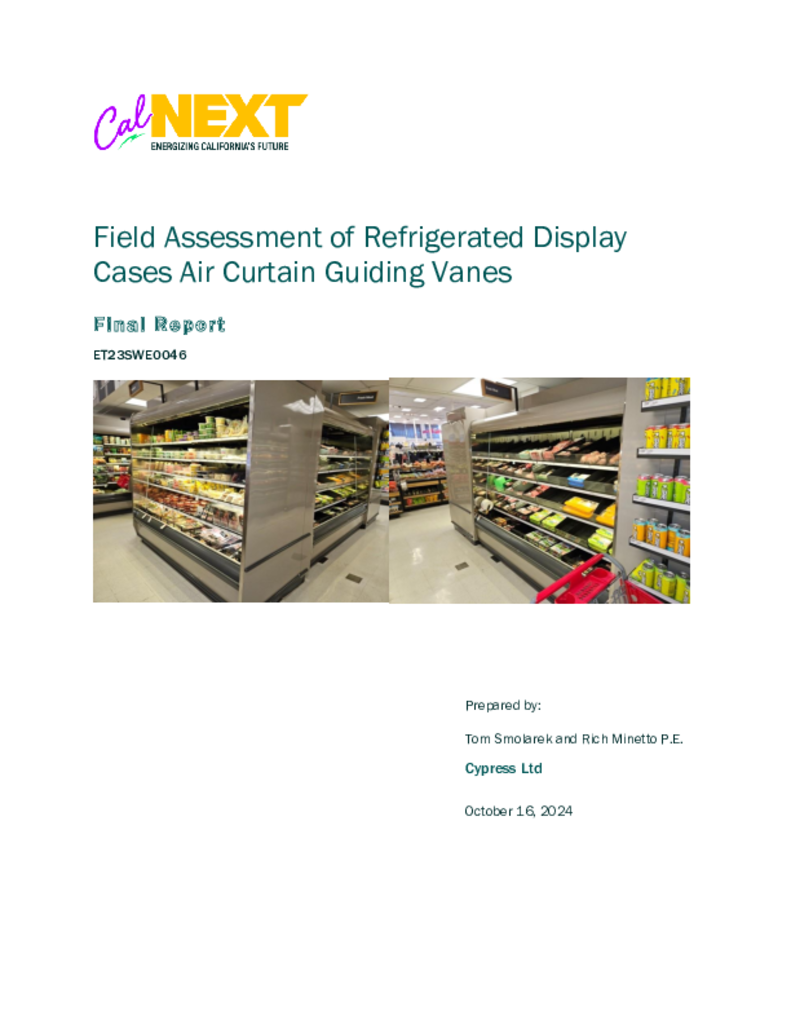ET23SWE0046 - Field Assessment of Refrigerated Display Cases Air Curtain Guiding Vanes
In January 2022 we completed a laboratory study (ET19SCE1110) on the proposed air vane technology under contract with the SCE ET&P group to investigate the benefits of installing air vanes on vertical open refrigerated display cases used in grocery stores. In the lab assessment, a reduction of 17 W per linear foot of storage was realized for meat and produce temperatures. This corresponded to a 20-25% reduction in compressor power usage for meat and produce. According to a prior SCE Air Vane study, there are an average of 330 linear feet of open display cases in a typical store, and an estimated 900,000 linear feet within the SCE service area alone savings could yield an average of 5.7 kW of load reduction per store, and 15.4MW grid reduction assuming market saturation. It is expected that the field assessment will meet or exceed this savings reduction.
A real-world field assessment is needed to update the lab findings. Air vanes are thin rigid strips (either a single strip or two strips) attached to the end of each shelf. They are positioned perpendicularly across the air curtain of the display case and direct air flow down, strengthening the barrier reducing infiltration between the refrigerated space and the warm moist air outside of the display case. Performance benefits were quantified in the lab test by the reduction in infiltration load which accounts for approx. 85% of open display case energy use.
Considering the large presence of open vertical refrigerated display cases in Southern California Edison’s service territory*, the potential energy savings could have a large impact throughout CA for the commercial target market. The project will estimate this potential from the field assessed results. It is estimated that a medium sized 50,000 ft2 supermarket vanes could potentially save approximately 50,000 kWh annually. There is additional potential energy savings if large supermarkets and small convenience stores were also to adopt the measure.
This project is designed to field verify savings, which has not been done, and understand relevant market barriers to inform future tech transfer and utility program. Two air vane designs will be field tested at three locations in different climate zones with a representative sample of different display case configurations. Two typical temperature set points will be selected. One for merchandizing meat at discharge air temperature of 32°F and the other for merchandizing products at discharge air temperature of 37°F.
*Estimated at 10,760 stores in the SCE service territory based on CEUS.
In January 2022, Southern California Edison (SCE) conducted a laboratory study (SCE 2022) to explore the benefits of installing air vanes on vertical open refrigerated display cases in grocery stores, the same technology being evaluated in this field assessment.
Air vanes are thin rigid strips — either a single strip or two strips — attached to the end of a grocery store's open refrigeration display shelves. These air vanes are positioned perpendicularly across the air curtain of the display case and direct airflow down, strengthening the barrier and reducing infiltration between the refrigerated space and the warm moist air outside of the display case. As detailed in the findings section of this report, the field assessment focused on four locations in different climate zones (CZs), to assess a representative sample of different display case configurations and temperatures. Overall temperatures for the open display cases ranged from 36 to 39°F. Inside-store temperatures ranged from 65°F to 72°F. Two air vane designs (0-degree angle and 17-degree angle) were used at the locations.
Given the large presence of open vertical refrigerated display cases used in grocery stores in California and also in SCE’s service territory, it is reasonable that if the measure achieved high adoption rates, the potential energy savings would be significant for the California commercial target market. This study concludes:
- Savings from air vanes were about 10 percent of total compressor energy consumption. Savings ranged from 9 percent to 14 percent, depending on CZ and application.
- Overall annual cost savings averaged $10.70/ft of installed air vane. This value ranged from $6.37 to $21.58/ft across CZ and applications.
- In this field assessment, energy savings averaged 16.79 W/ft of installed air vane as compared to the 17 W/ft in the lab study. Field savings values ranged from 7.42 to 26.53 W/ft across CZ and applications. The results show that on average the field assessment is within a reasonable error (five percent) of the laboratory study for average savings in W/ft.
- Overall kilowatt-hour (kWh) savings averaged 129.46 kWh/ft of installed air vane. This value ranged from 64.98 to 232.44 kWh/ft across CZ and applications.
- Based on an estimated average of 330 ft of potential air vane coverage in a typical store from a prior study (SCE 2009) and using the overall average from this field assessment, our results suggest that for a 330 ft coverage area total, the annual savings would be 42,722 kWh/yr, which is 15 percent below lab study estimates. As detailed herein, the differences between a laboratory assessment and the actual field installation account for these differences.

